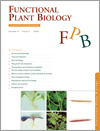
Functional Plant Biology
Volume 47 Number 5 2020
Plant roots perform important functions anchoring the plant and providing it with minerals and water. At the same time, they are involved in selective uptake and avoidance of certain soil compounds and thus accomplish barrier function which is not considered in the contemporary literature. In this critical review, we analyse the toolkit of morpho-anatomical, structural, and other components which operate at a cellular, tissue, and organ level that support the view that the root as organ fulfils barrier function.
FP19221Chloride and amino acids are associated with K+-alleviated drought stress in tea (Camellia sinesis)
Drought is one of the main limiting factors affecting tea plant yield and tea quality. We found that chloride and amino acids are important components associated with K+-alleviated drought stress in tea plants. Our results could be used to identify pathways involved in the establishment of K+-enhanced drought tolerance in tea plants.
FP19270Comparative analysis of the plastid conversion, photochemical activity and chlorophyll degradation in developing embryos of green-seeded and yellow-seeded pea (Pisum sativum) cultivars
 , Olga Shiroglazova, Galina Vinogradova, Irina Leppyanen, Ekaterina Dinastiya, Olga Yakovleva, Elena Dolgikh, Galina Titova, Andrej Frolov and Sergei Medvedev
, Olga Shiroglazova, Galina Vinogradova, Irina Leppyanen, Ekaterina Dinastiya, Olga Yakovleva, Elena Dolgikh, Galina Titova, Andrej Frolov and Sergei Medvedev 
Developing seeds of some higher plants are photosynthetically active and contain chlorophylls, which are typically destroyed during seed maturation. However, in some crops, chlorophylls degrade incompletely, which compromises seed quality, and represents a severe challenge for farmers. Here we address dynamics of plastid conversion and photochemical activity alterations, accompanying chlorophylls degradation in maturing embryos of yellow- and green-seeded cultivars of pea (Pisum sativum). Our data enhance the existing knowledge about mechanisms, underlying incomplete chlorophylls degradation during seed maturation.
FP19051Genetic diversity of limonene synthase genes in Rongan kumquat (Fortunella crassifolia)
D-limonene synthase is a key enzyme for synthesis of limonene, which is the largest component of Citrus essential oil. A large number of d-limonene synthase genes were identified in Fortunella crassifolia. Previous reports have only identified a few d-limonene synthase genes in some Citrus species. The genetic diversity of d-limonene synthase gene in F. crassifolia will help us to understand the evolution and functional diversity of limonene synthase.
FP19246Agronomic, physiological and molecular characterisation of rice mutants revealed the key role of reactive oxygen species and catalase in high-temperature stress tolerance
 , Amjad Hameed, Muhammad Ashraf, Abdus Salam Khan, Zia-ul- Qamar, Xueyong Li and Kadambot H. M. Siddique
, Amjad Hameed, Muhammad Ashraf, Abdus Salam Khan, Zia-ul- Qamar, Xueyong Li and Kadambot H. M. Siddique
Heat stress has become a serious threat to global rice production, which is likely due to the changing climate scenario. Efforts to develop high-yielding cultivars have reduced the genetic variability in rice to withstand harsh environmental conditions. This study aimed to identify novel heat-tolerant mutants via gamma irradiation to provide a unique genetic resource for breeding programs and reliable selection indices for screening heat-tolerant rice germplasm during early growth.
Seed abortion hinders the propagation of many woody plants. We identified a gene called DiMYB1 from dove tree, a rare and endangered ornamental plant, and observed that overexpression of DiMYB1 can cause aggravated seed abortion in A. thaliana. Our results indicated that DiMYB1 plays a critical role in seed development in dove tree, which is important for understanding the mechanism of seed abortion and improving this species’ fecundity.
FP19342Overexpression of a putative nitrate transporter (StNPF1.11) increases plant height, leaf chlorophyll content and tuber protein content of young potato plants

Nitrate fertilisers are commonly used to improve the yield and quality of crops. However, nitrate is a costly resource, and losses into the environment have negative impacts on ecosystems. By overexpressing a nitrate transporter gene (StNPF1.11), we discovered that plant height, leaf chlorophyll content and tuber protein content were increased in young potato plants. These findings show that biological processes underlying plant nitrate nutrition can potentially be exploited to improve the sustainability and quality of potato and other crops.



